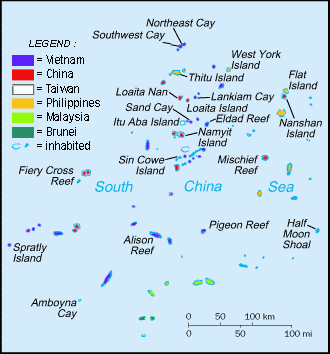
Back جزر سبراتلي Arabic Islles Spratly AST Spratli arxipelaqı Azerbaijani Kaislahan kan Spratly BCL Спратлі Byelorussian Спратли Bulgarian Inizi Spratly Breton Illes Spratly Catalan Kapupud-ang Kagawasan CEB Spratlyho ostrovy Czech
The Spratly Islands (Filipino: Kapuluan ng Kalayaan;[1] Mandarin Chinese: 南沙群島/南沙群岛; pinyin: Nánshā Qúndǎo; Malay: Kepulauan Spratly; Vietnamese: Quần đảo Trường Sa) are a disputed archipelago in the South China Sea. Composed of islands, islets, cays,[2] and more than 100 reefs, sometimes grouped in submerged old atolls,[3] the archipelago lies off the coasts of the Philippines, Malaysia, and southern Vietnam. Named after the 19th-century British whaling captain Richard Spratly who sighted Spratly Island in 1843, the islands contain less than 2 km2 (490 acres) of naturally occurring land area, which is spread over an area of more than 425,000 km2 (164,000 sq mi).
The Spratly Islands are one of the major archipelagos in the South China Sea which complicate governance and economics in this part of Southeast Asia due to their location in strategic shipping lanes. The islands are largely uninhabited, but offer rich fishing grounds and may contain significant oil and natural gas reserves,[4][5][6] and as such are important to the claimants in their attempts to establish international boundaries. Some of the islands have civilian settlements, but of the approximately 45 islands, cays, reefs and shoals that are occupied, all contain structures that are occupied by military forces from Malaysia, China (PRC), Taiwan (ROC), the Philippines, and Vietnam. Additionally, Brunei has claimed an exclusive economic zone in the southeastern part of the Spratly Islands, which includes the uninhabited Louisa Reef.
- ^ Anda, Redempto (17 July 2012). "Government told of China buildup 2 months ago". Philippine Inquirer. Archived from the original on 2 November 2013. Retrieved 29 October 2013.
- ^ Claudius Madrolle (1939). "La question de Hai-nan et des Paracels" [The question of Hai-nan and Paracel]. Politique étrangère (in French). 4 (3): 302–312. doi:10.3406/polit.1939.5631. Archived from the original on 5 June 2018. Retrieved 7 May 2016.
- ^ Cite error: The named reference
ECOwas invoked but never defined (see the help page). - ^ Owen, N. A. and C. H. Schofield, 2012, Disputed South China Sea hydrocarbons in perspective. Marine Policy. vol. 36, no. 3, pp. 809–822.
- ^ "Why is the South China Sea contentious?". BBC. 12 July 2016.
- ^ "Q&A: South China Sea dispute". BBC News. 13 June 2011. Archived from the original on 17 October 2013. Retrieved 30 October 2013.
© MMXXIII Rich X Search. We shall prevail. All rights reserved. Rich X Search

